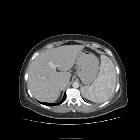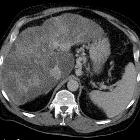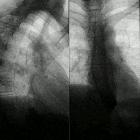Primary biliary cholangitis (PBC)











Primary biliary cholangitis (PBC) is a chronic progressive cholestatic liver disease that is the cause of 1-2% of deaths from cirrhosis and constitutes the third most common indication for liver transplantation in adults.
Terminology
The name of this disease was changed from primary biliary cirrhosis to primary biliary cholangitis—however, it was also decided to keep the abbreviation as PBC—in 2014 .
Epidemiology
The typical patient is a middle-aged woman presenting with symptoms of fatigue and pruritus and laboratory test evidence of cholestasis.
Clinical presentation
Clinical features include :
- pruritus (often the first symptom)
- jaundice
- skin hyperpigmentation, especially of arms and trunk
- xanthomata and xanthelasma due to hypercholesterolemia
- interestingly hypercholesterolemia does not confer an increased risk of death from atherosclerosis
- digital clubbing
- fatigue
- right upper quadrant abdominal discomfort
Pathology
Primary biliary cholangitis is characterized by the destruction of small intrahepatic bile ducts, portal inflammation, and progressive scarring. The cause of primary biliary cholangitis is unknown, but it is probably due to an inherited abnormality of immunoregulation.
Markers
Serum anti-mitochondrial antibody (AMA) tests are highly sensitive and specific for primary biliary cholangitis (85-100%).
Associations
- cholelithiasis (~40%)
- other autoimmune diseases, e.g. Sjögren syndrome (~75%), autoimmune thyroiditis (~25%), systemic sclerosis (~10%)
- interstitial lung disease: ~15%
- interstitial lung disease associated with primary biliary cholangitis
- hepatocellular carcinoma develops in ~5%
- additional risk in older patients, males, history of diabetes mellitus or past hepatitis B virus infection
- hepatic osteodystrophy
Radiographic features
MRI
- T2: if parenchymal lace-like fibrosis and periportal halo sign are seen together the sensitivity for PBC can approach 70%
Other features detectable on MRI include:
- periportal hyperintensity (cuffing)
- segmental hypertrophy, notably of the caudate lobe
- hepatic surface irregularity due to regenerative nodules
- regional lymphadenopathy: tends to dominate in the gastrohepatic ligament and porta hepatis
- splenomegaly
Treatment and prognosis
Ursodeoxycholic acid is the mainstay for medical management . In cases of primary biliary cholangitis that advance despite pharmacotherapy, liver transplantation clearly improves the survival and quality of life.
Primary biliary cholangitis can recur after transplantation but with a frequency much lower than that for hepatitis and other diseases.
Complications
Siehe auch:
- Leberzirrhose
- Splenomegalie
- Systemische Sklerodermie
- Primär sklerosierende Cholangitis
- Autoimmunhepatitis
- Progressive familiäre intrahepatische Cholestase (PFIC)
- AMA-negative PBC
und weiter:

 Assoziationen und Differentialdiagnosen zu Primär biliäre Zirrhose:
Assoziationen und Differentialdiagnosen zu Primär biliäre Zirrhose:




